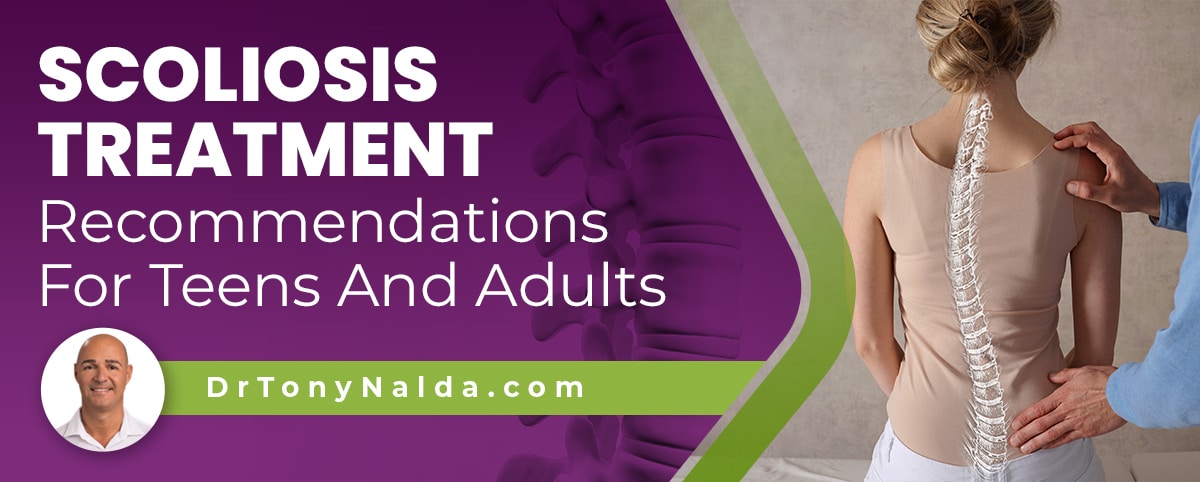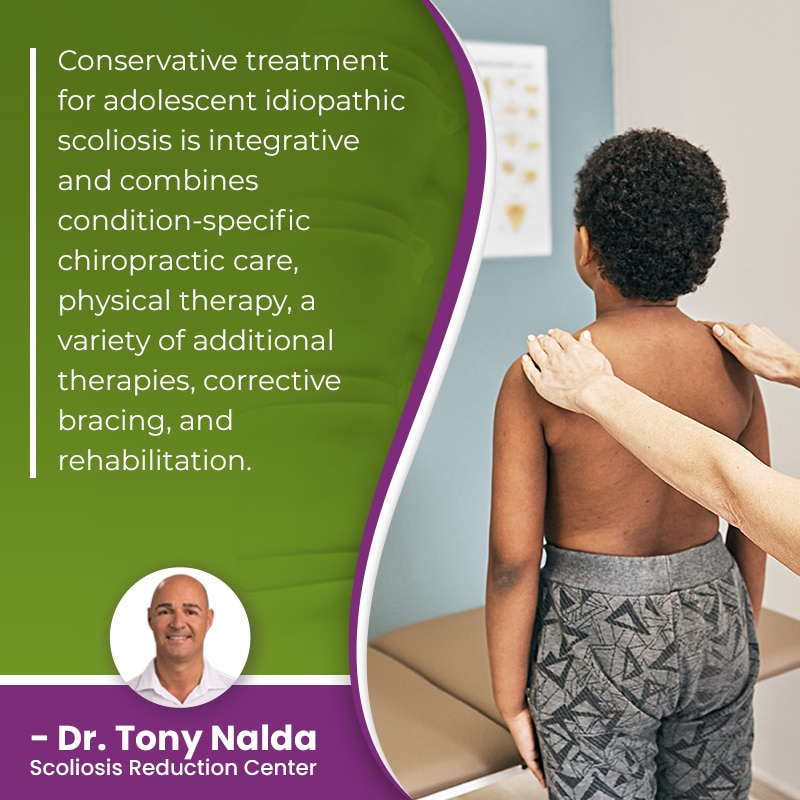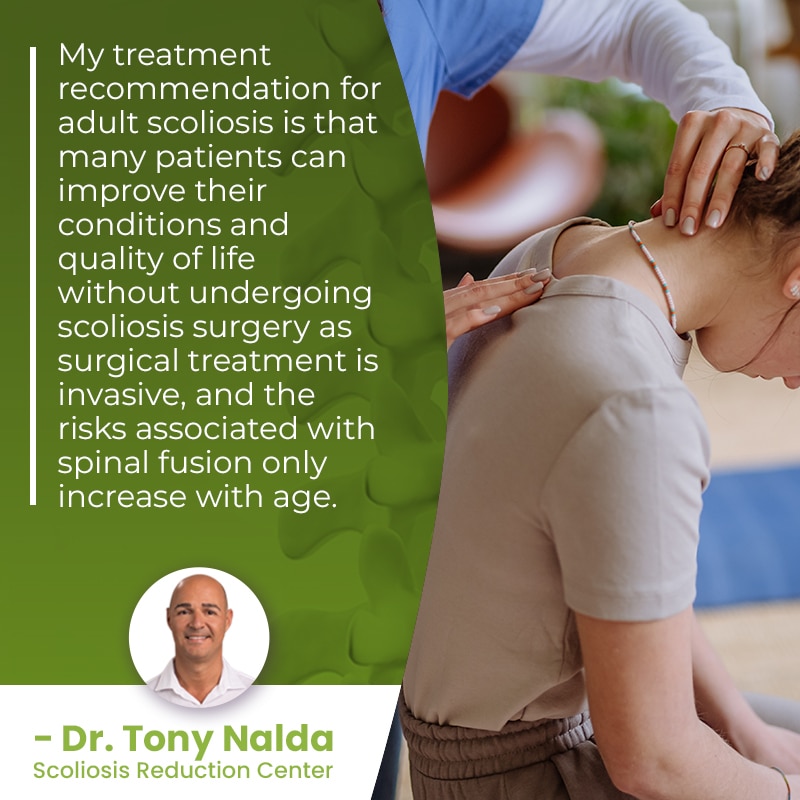Scoliosis Treatment: Recommendations For Teens And Adults

An unnatural curvature of the spine introduces a lot of uneven forces to the body, and this can affect any age, but scoliosis is most prevalent in children. An important condition feature to understand is its progressive nature, and as growth is what triggers progression, adults are less at risk for rapid progression than adolescents; continue reading for additional treatment recommendations for teens and adults.
Scoliosis affects all ages, and different severity levels and types have different treatment needs. When it comes to the differences between adolescent idiopathic scoliosis and adult scoliosis treatment, the focus differs based on progressive rates and pain management.
As a patient's scoliosis journey begins with a diagnosis, let's start with how the condition is diagnosed.
Table of Contents
Diagnosing Scoliosis
Scoliosis involves the development of an unnatural sideways-bending and rotating spinal curve, and as a progressive condition, there is no curing scoliosis, but it can be highly treatable.
For an unnatural spinal curve to be diagnosed as scoliosis, it also has to meet a minimum size requirement: Cobb angle measurement of at least 10 degrees.
A diagnosis is reached through a combined physical examination that includes taking the patient's medical and family history, an Adam's forward bend test, and X-ray results.
An X-ray is needed to truly see what's happening in and around the spine and to confirm a patient's Cobb angle; the measurement involves drawing lines from the tops and bottoms of the curve's most-tilted vertebrae at its apex, and the resulting angle is expressed in degrees.
The higher a patient's Cobb angle, the larger the size of the scoliotic curve is, the further out of alignment the spine is, and the more noticeable the condition's effects are likely to be.
As the current topic is treatment options for adolescents and adults with scoliosis, lets first touch on the different ways that scoliosis affects these age groups because that's what shapes a condition's treatment needs.
How Scoliosis Affects Teens vs Adults
Scoliosis affects all ages, but it is most commonly diagnosed in children, and the most common type of scoliosis overall is adolescent idiopathic scoliosis, diagnosed between the ages of 10 and 18.
The idiopathic designation means not clearly associated with a single-known cause, and idiopathic scoliosis is the most common type to also affect adults.
In fact, approximately 80 percent of known diagnosed scoliosis cases are classified as idiopathic scoliosis, and the remaining 20 percent are associated with known causes: neuromuscular scoliosis, degenerative scoliosis, and congenital scoliosis.
Condition type is determined by causation, and scoliosis types with known causes are considered atypical so will have unique treatment needs; for example, neuromuscular scoliosis is caused by the presence of a larger neuromuscular condition such as cerebral palsy, spina bifida, and muscular dystrophy.
So treatment options for neuromuscular scoliosis, whether it has developed in an adolescent or an adult, will have to focus on the larger neuromuscular condition, and this complicates the treatment process.
As progression is triggered by growth, adolescents are the most at risk for rapid progression because of the rapid and unpredictable growth spurts of puberty, but in adults who have reached skeletal maturity, that trigger has been removed, and this is why a main focus of treating scoliosis in adolescents is on reducing the curve and holding it there throughout growth; the focus of curvature reductions for adults is more about reducing them back to where they were prior to becoming painful, which I'll explain in more in detail later.
The more severe a condition, the more noticeable its effects are likely to be, and when we're talking about adolescents, the main signs and effects involve postural changes.
Adolescent Idiopathic Scoliosis and Postural Deviation
The main effect of scoliosis in adolescents is postural deviation caused by the condition's uneven forces disrupting the body's overall symmetry.
Common postural changes can include:
- Uneven shoulders
- Uneven shoulder blades
- The development of a rib cage arch
- An uneven waistline
- Arms and legs that appear to hang at different lengths
Additional condition effects can include changes to gait, balance, coordination, and clothing suddenly seeming ill-fitting.
Treatment Recommendations for Adolescents
Because of the risks of rapid-phase progression, my treatment recommendation for adolescents is a proactive conservative treatment approach that works towards counteracting the condition's progressive nature by achieving significant curvature reductions, holding them there despite the constant trigger of growth, and close monitoring to observe how the spine is responding both to growth and treatment.
 Conservative treatment for adolescent idiopathic scoliosis is integrative and combines condition-specific chiropractic care, physical therapy, a variety of additional therapies, corrective bracing, and rehabilitation.
Conservative treatment for adolescent idiopathic scoliosis is integrative and combines condition-specific chiropractic care, physical therapy, a variety of additional therapies, corrective bracing, and rehabilitation.
Chiropractic care includes a variety of techniques and manual adjustments that can realign the spine and restore as much of the spine's natural curves as possible, and physical therapy and scoliosis-specific exercises can help increase core strength so the spine receives optimal support from its surrounding muscles.
Physical therapy can also help address poor posture and any related muscle imbalances.
Corrective bracing works by applying pressure to the spine at strategic locations to push the spine into a corrective position, and this can be particularly effective on growing spines so is a common facet of treatment for teen scoliosis.
Rehabilitation can involve continued chiropractic care and a series of custom-prescribed home exercises for further healing and stabilizing the spine from home.
Adult Scoliosis and Pain
We've already discussed how progression differs between adolescents and adults and why; let's now explore why pain is the most noticeable condition effect in adults, but not in children.
Scoliosis doesn't become a compressive condition until skeletal maturity has been reached, and it's compression of the spine and its surrounding muscles and nerves that causes the majority of condition-related pain.
Compression is uneven pressure, and an abnormal curvature of the spine introduces a lot of uneven forces not just to the spine and its surrounding muscles and nerves, but the entire body.
While adults also experience the types of postural changes that adolescents do, pain is the more noticeable condition effect; it's back pain and pain that radiates into the extremities due to nerve compression that brings most adults in to see me for a diagnosis and treatment.
While there is always traditional surgical intervention for scoliosis treatment, nonsurgical treatment has proven results and is less invasive and risky, particularly for adults that are also facing age-related spinal degeneration.
The most common type of scoliosis to affect adults is idiopathic scoliosis, and these cases were once adolescents whose scoliosis was undiagnosed and untreated during adolescence; a common scenario is that when mild, scoliosis can easily go unnoticed in adolescents, but once skeletal maturity is reached and the condition becomes compressive, that's when the symptom of pain calls attention to what's going on.
The second most common type of scoliosis to affect adult patients is degenerative scoliosis, and this is caused by natural age-related spinal degeneration and the cumulative effect of negative lifestyle factors: carrying excess weight, a sedentary lifestyle, chronic poor posture, excessive consumption of alcohol and/or smoking, and repeatedly lifting heavy objects incorrectly and straining the spine.
The focus of adult scoliosis treatment is on reducing the size of the scoliotic curve, but instead of a significant curvature reduction as is the goal with adolescents, reducing the curve back to where it was prior to becoming painful is the goal.
In addition, there is not such a focus on counteracting progression when treating adult scoliosis because the trigger of growth has been removed so there is ample time to work towards increasing spinal stabilization, pain management, and reducing a scoliosis curve back to the size it was prior to becoming painful.
Gentle chiropractic care and physical therapy can help in the same ways they do with adolescents, but bracing for adults is more about increasing spinal stabilization and short-term pain management than it is about augmenting corrective results.
Preserving spinal strength and function is an important part of treatment for scoliosis in adults.
 So my treatment recommendation for adult scoliosis is that many patients can improve their conditions and quality of life without undergoing scoliosis surgery as surgical treatment is invasive, and the risks associated with spinal fusion only increase with age.
So my treatment recommendation for adult scoliosis is that many patients can improve their conditions and quality of life without undergoing scoliosis surgery as surgical treatment is invasive, and the risks associated with spinal fusion only increase with age.
Conclusion
Here at the Scoliosis Reduction Center, I believe in the power of alternative treatments for scoliosis that don't involve spinal surgery.
A scoliotic spinal curvature needs to be taken seriously at any age, but for adolescents, this is the age group most at risk for rapid-phase progression, so a treatment focus is on monitoring how a patient's spine is responding to growth, treatment, and apportioning treatment disciplines accordingly.
I recommend starting with treatment options that aren't as invasive as posterior spinal fusion because it carries some serious potential risks, complications, and side effects so should be considered carefully, and most patients with scoliosis, particularly those with early intervention, don't need surgical treatment for scoliosis.
I recommend being proactive by starting treatment as close to the time of diagnosis, regardless of age, and this is because scoliosis only gets more complex to treat as it progresses, and it's far more effective to proactively work towards preventing progression and increasing condition effects, than it is to attempt to reverse those effects once they're in place.
Dr. Tony Nalda
DOCTOR OF CHIROPRACTIC
After receiving an undergraduate degree in psychology and his Doctorate of Chiropractic from Life University, Dr. Nalda settled in Celebration, Florida and proceeded to build one of Central Florida’s most successful chiropractic clinics.
His experience with patients suffering from scoliosis, and the confusion and frustration they faced, led him to seek a specialty in scoliosis care. In 2006 he completed his Intensive Care Certification from CLEAR Institute, a leading scoliosis educational and certification center.
About Dr. Tony Nalda
 Ready to explore scoliosis treatment? Contact Us Now
Ready to explore scoliosis treatment? Contact Us Now





